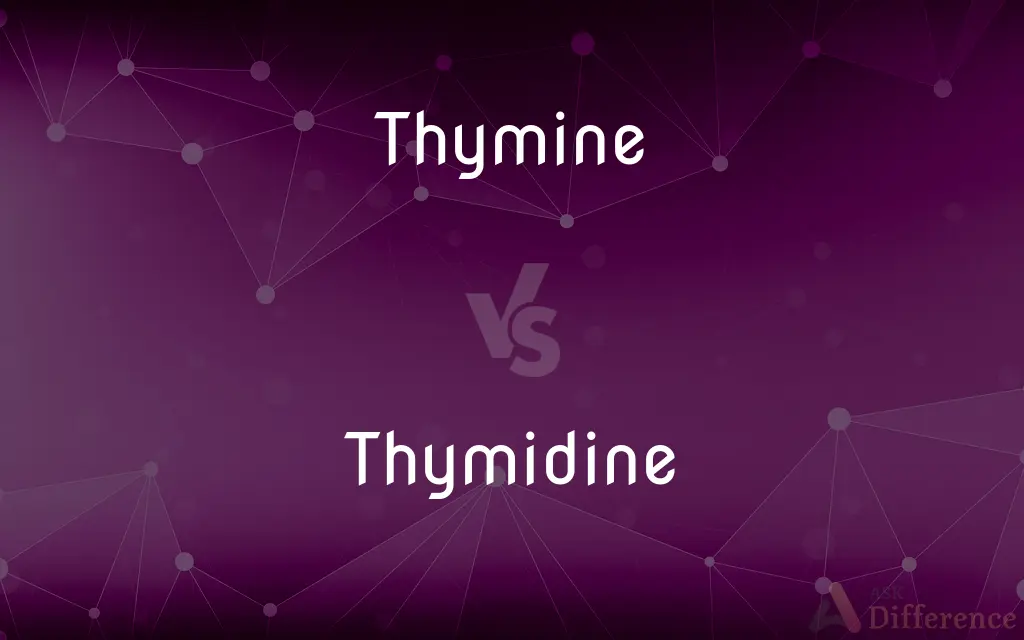Thymine vs. Thymidine — What's the Difference?
Edited by Tayyaba Rehman — By Fiza Rafique — Updated on October 1, 2023
Thymine is one of the four nucleobases in DNA, while Thymidine refers to the nucleoside comprising Thymine attached to a deoxyribose sugar.

Difference Between Thymine and Thymidine
Table of Contents
ADVERTISEMENT
Key Differences
Thymine and Thymidine, though closely related, serve distinct roles in the realm of molecular biology. Thymine is one of the four primary nucleobases found in the DNA of all living organisms. Acting as a core component, it pairs with adenine, ensuring the stability and integrity of the DNA structure.
Thymidine, in contrast, is a nucleoside, which means it is a compound that consists of Thymine linked to a sugar molecule, specifically deoxyribose. This makes Thymidine a building block of DNA, as it can be incorporated into the DNA strand during replication or repair processes.
While Thymine's role is largely static, being embedded in the DNA strand and forming base pairs, Thymidine is dynamic. Thymidine can be phosphorylated to form Thymidine triphosphate (dTTP), which is then used as a substrate by enzymes like DNA polymerase during DNA synthesis.
In essence, while both Thymine and Thymidine play pivotal roles in DNA and its synthesis, they differ in their chemical structure and function. Thymine operates as a base, ensuring the proper pairing in the DNA helix, while Thymidine acts as a precursor, getting incorporated into the growing DNA chain during replication.
Comparison Chart
Type
Nucleobase
Nucleoside
ADVERTISEMENT
Composition
Single ring compound
Thymine + Deoxyribose sugar
Role
Base pairing in DNA
Building block in DNA replication
Interaction
Pairs with Adenine
Can be phosphorylated
Presence
Found within DNA strands
Circulates and can be incorporated into DNA strand
Compare with Definitions
Thymine
An organic compound with a single-ring structure.
Thymine has a chemical formula of C5H6N2O2.
Thymidine
Can be phosphorylated.
Once phosphorylated, thymidine forms dTTP.
Thymine
A nucleobase in DNA.
Thymine pairs with adenine in a DNA molecule.
Thymidine
Compound used in research.
Thymidine analogs are used to track DNA synthesis in cells.
Thymine
One of the four primary bases in DNA.
DNA consists of adenine, cytosine, guanine, and thymine.
Thymidine
Contains a sugar molecule.
The sugar molecule in thymidine is deoxyribose.
Thymine
A pyrimidine derivative.
Thymine is a pyrimidine, just like cytosine.
Thymidine
A precursor in DNA synthesis.
Thymidine can be converted to dTTP for DNA replication.
Thymine
Participates in base pairing.
Thymine forms hydrogen bonds with adenine.
Thymidine
A nucleoside consisting of thymine and deoxyribose.
Thymidine is incorporated into the DNA strand during replication.
Thymine
Thymine (T, Thy) is one of the four nucleobases in the nucleic acid of DNA that are represented by the letters G–C–A–T. The others are adenine, guanine, and cytosine. Thymine is also known as 5-methyluracil, a pyrimidine nucleobase.
Thymidine
Thymidine (other names deoxythymidine, deoxyribosylthymine, thymine deoxyriboside) is a pyrimidine deoxynucleoside. Deoxythymidine is the DNA nucleoside T, which pairs with deoxyadenosine (A) in double-stranded DNA. In cell biology it is used to synchronize the cells in G1/early S phase.
Thymine
A pyrimidine base, C5H6N2O2, that is an essential constituent of DNA.
Thymidine
A nucleoside, C10H14N2O5, composed of thymine and deoxyribose.
Thymine
A heterocyclic base, 5-methylpyrimidine-2,4(1H,3H)-dione; it pairs with adenine in DNA.
Thymidine
The nucleoside consisting of a combination of deoxyribose and thymine
Thymine
A base found in DNA (but not in RNA) and derived from pyrimidine; pairs with adenine
Thymidine
A nucleoside component of DNA; composed of thymine and deoxyribose
Common Curiosities
Are Thymine and Thymidine the same thing?
No, Thymine is a nucleobase, while Thymidine is a nucleoside consisting of thymine and deoxyribose.
How is Thymidine related to Thymine?
Thymidine is a nucleoside made of thymine attached to a deoxyribose sugar.
What role does Thymidine play in DNA replication?
Thymidine can be phosphorylated to form dTTP, which is incorporated into the DNA strand during replication.
Can Thymine be found outside of DNA?
Thymine is primarily found in DNA, not RNA. In RNA, uracil replaces thymine.
What happens if Thymine base pairing is incorrect?
Incorrect base pairing can lead to mutations during DNA replication.
Is Thymidine found in RNA?
No, Thymidine is specific to DNA. RNA contains uridine instead.
What does Thymine pair with in DNA?
Thymine pairs with adenine.
How does Thymine ensure the stability of DNA?
Thymine forms hydrogen bonds with adenine, ensuring proper base pairing in DNA.
Why is Thymidine important in research?
Thymidine analogs are used in research to monitor DNA synthesis and cell proliferation.
What replaces Thymine in RNA?
Uracil replaces Thymine in RNA.
What's the significance of Thymine's chemical formula, C5H6N2O2?
It signifies the molecule's structure, helping scientists understand its properties and interactions.
How does Thymidine become a part of DNA?
Thymidine can be phosphorylated to dTTP, which is then incorporated by enzymes during DNA synthesis.
What is the structure of Thymine?
Thymine is a pyrimidine with a single-ring structure.
Can Thymidine be used to measure cell growth?
Yes, using labeled thymidine can help track DNA synthesis and thereby measure cell growth.
Why don't we talk about Thymidine as much as Thymine in genetics?
Thymine's role in base pairing makes it central to genetics, while Thymidine's role is more focused on DNA replication.
Share Your Discovery

Previous Comparison
Workgroup vs. Domain
Next Comparison
Cockatoo vs. ParrotAuthor Spotlight
Written by
Fiza RafiqueFiza Rafique is a skilled content writer at AskDifference.com, where she meticulously refines and enhances written pieces. Drawing from her vast editorial expertise, Fiza ensures clarity, accuracy, and precision in every article. Passionate about language, she continually seeks to elevate the quality of content for readers worldwide.
Edited by
Tayyaba RehmanTayyaba Rehman is a distinguished writer, currently serving as a primary contributor to askdifference.com. As a researcher in semantics and etymology, Tayyaba's passion for the complexity of languages and their distinctions has found a perfect home on the platform. Tayyaba delves into the intricacies of language, distinguishing between commonly confused words and phrases, thereby providing clarity for readers worldwide.















































